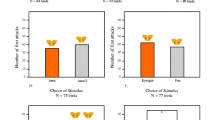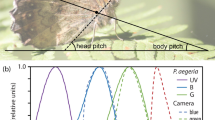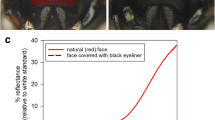Abstract
Junonia evarete Cramer is a fast-flying butterfly that perches on the ground with wings opened exhibiting four eyespots close to wing borders. These eyespots presumably function either to intimidate predators, like insectivorous birds, or to deflect bird attacks to less vital parts of the body. We assessed the form, frequency, and location of beak marks on the wings of wild butterflies in central Brazil during two not consecutive years. We found that almost 50% of males and 80% of females bore signals of predator attacks (wing tears), most of them consisting of partially or totally V-shaped forms apparently produced by birds. Males were significantly less attacked and showed a lower proportion of attacks on eyespots than females, suggesting they are better to escape bird attacks. In contrast, females were heavily attacked on eyespots. Eyespot tears in females were higher (and significant different) than expected by chance, indicating that birds do attempt to reach the eyespots when striking on these butterflies. Other comparisons involving the proportion of tears directed or not directed to eyespots in males and females are presented and discussed.



Similar content being viewed by others
References
Berwaerts K, VanDick H, Aerts P (2002) Does flight morphology relate to flight performance? An experimental test with the butterfly Pararge aegeria. Func Ecol 16:484–491
Blest AD (1957) The function of eyespot patterns in the Lepidoptera. Behaviour 11:209–256
Brown KS Jr (1988) Mimicry, aposematism and crypsis in Neotropical Lepidoptera: the importance of dual signals. Bull Soc Zool France 113:83–101
Carpenter GDH (1941) The relative frequency of beak marks on butterflies of different edibility to birds. Proc Zool Soc Lond (A) 111:223–231
Chai P (1986) Field observation and feeding experiments on the responses of rufous-tailed jacamars (Galbula ruficauda) to free-flying butterflies in a tropical rainforest. Biol J Linn Soc 29:161–189
Daniels EV (2012) Seasonal wing colour plasticity varies dramatically between buckeye butterfly populations in different climatic zones. Ecol Entom 37:155–159
DeVries PJ (1987) The butterflies of Costa Rica and their natural history. Papilionidae, Pieridae, Nymphalidae. Princeton University Press, Princeton, XXII + 327p.
DeVries PJ (2002) Differential wing toughness in distasteful and palatable butterflies: direct evidence supports unpalatable theory. Biotropica 34:176–181
DeVries PJ (2003) Tough African models and weak mimics: new horizons in the evolution of bad taste. J Lepid Soc 57:235–238
Edmunds M (1974) Defence in animals: a survey of anti-predator defences. Longmans, Harlow
Ehrlich PR, Gilbert LE (1973) Population structure and dynamics of the tropical butterfly Heliconius ethilla. Biotropica 5:69–82
Endler JA (1991) Interactions between predator and prey. In: Krebs JR, Davies RB (eds) Behavioral ecology. Blackwell Scientific, Oxford, pp 169–196
Endler JA, Mappes J (2004) Predator mixes and the conspicuousness of aposematic signals. Am Nat 163:532–547
Hill RI, Vaca JF (2004) Differential wing strength in Pierella butterflies (Nymphalidae, Satyrinae) supports the deflection hypothesis. Biotropica 36:362–370
Ide J (2006) Sexual and seasonal differences in the frequency of beak marks on the wings of two Lethe butterflies. Ecol Res 21:453–459
Kodandaramaiah U, Vallin A, Wiklund C (2009) Fixed eyespot display in a butterfly thwarts attacking birds. Anim Behav 77:1415–1419
Lyytinen A, Brakefield PM, Mappes J (2003) Significance of butterfly eyespots as an anti-predator device in ground-based and aerial attacks. Oikos 100:372–379
Lyytinen A, Brakefield PM, Lindström L, Mappes J (2004) Does predation maintain eyespot plasticity in Bicyclus anynana? Proc R Soc B 272:279–283
Marden JH, Chai P (1991) Aerial predation and butterfly design: how palatability, mimicry and the need for evasive flight constrain mass allocation. Am Nat 138:15–36
Merilaita S, Vallin A, Kodandaramaiah U, Dimitrova M, Ruuskanen S, Laaksonen T (2011) Number of eyespots and their intimidating effect on naive predators in the peacock butterfly. Behav Ecol 22:1326–1331
Ohsaki N (1995) Preferential predation of female butterflies and the evolution of Batesian mimicry. Nature 378:173–175
Olofsson M, Vallin A, Jakobsson S, Wiklund C (2010) Marginal eyespots on butterfly wings deflect bird attacks under low light intensities with UV wavelengths. PloS ONE 5:e10798
Olofsson M, Vallin A, Jakobsson S, Wiklund C (2011) Winter predation on two species of hibernating butterlies: monitoring rodent attacks with infrared cameras. Anim Behav 81:529–534
Pinheiro CEG (1996) Palatability and escaping ability in Neotropical butterflies: tests with wild Kingbirds (Tyrannus melancholicus, Tyrannidae). Biol J Linn Soc 59:351–365
Pinheiro CEG (2003) Does Müllerian mimicry work in nature? Experiments with butterflies and birds (Tyrannidae). Biotropica 35:356–364
Pinheiro CEG (2007) Asynchrony in daily activity patterns of butterfly models and mimics. J Trop Ecol 23:119–123
Pinheiro CEG (2011) On the evolution of warning coloration, Batesian and Müllerian mimicry in Neotropical butterflies: the role of jacamars (Galbulidae) and tyrant-flycatchers (Tyrannidae). J Avian Biol 42:277–281
Poulton EB (1890) The colour of animals, their meaning and use. Especially considered in the case of insects. Kegan Paul, Trench, Trubner, London
Robbins RK (1980) The lycaenid false head hypothesis: historical review and quantitative analysis. J Lepid Soc 34:194–208
Robbins RK (1981) The “false head” hypothesis: predation and wing pattern variation of lycaenid butterflies. Am Nat 118:770–775
Sargent TD (1976) Legion of night: the underwing moths. University of Massachussets Press, Amherst, USA
Srygley RB, Chai P (1990) Flight morphology of neotropical butterflies: palatability and distribution of mass to the thorax and abdomen. Oecologia 84:491–499
Srygley RB, Dudley R (1993) Correlations of the position of center of body mass with butterfly escape tactics. J Exp Biol 174:155–166
Stevens M (2005) The role of eyespots as anti-predator mechanisms, principally demonstrated in the Lepidoptera. Biol Rev 80:573–588
Stevens M, Hopkins E, Hinde W, Adcock A, Connoly Y, Troscianko T, Cuthill LC (2007) Field experiments on the effectiveness of eyespots as predator deterrents. Anim Behav 74:1215–1227
Stevens M, Hardman CJ, Stubbins CL (2008) Conspicuousness, not eye mimicry, makes “eyespots” effective antipredator signals. Behav Ecol 19:525–531
Swynnerton CFM (1926) An investigation into the defences of butterflies of the genus Charaxes, p. 478–506. In: 3rd International Congress of Entomology (1925), Zürich
Thomas CD, Hill JK, Lewis OT (1998) Evolutionary consequences of habitat fragmentation in a localized butterfly. J Anim Ecol 67:485–497
Tonner M, Novotny V, Leps J, Komarec S (1993) False head wing pattern of the Burmese junglequeen butterfly and the deception of avian predators. Biotropica 25:474–478
Vallin A, Jakobsson S, Lind J, Wiklund C (2005) Prey survival by predator intimidation: an experimental study of peacock butterfly defence against blue tits. Proc R Soc B 272:1203–1207
Vlieger L, Brakefield PM (2007) The deflection hypothesis: eyespots on the margins of butterfly wings do not influence predation by lizards. Biol J Linn Soc 92:661–667
Wourms MK, Wasserman FE (1985) Butterfly wing markings are more advantageous during handling than during the initial strike of an avian predator. Evolution 39:845–851
Acknowledgments
We are grateful to Dr Guarino R. Colli for comments and suggestions on a previous version of the manuscript; Instituto Chico Mendes (Ministério do Meio Ambiente, Brazil) for permission to capture and mark wild J. evarete butterflies (license 28056-1 ICM-BIO) and FAPDF/CNPq/Pronex (project number 563/2009) for financial support.
Author information
Authors and Affiliations
Corresponding author
Additional information
Edited by José R Trigo – UNICAMP
Rights and permissions
About this article
Cite this article
Pinheiro, C.E.G., Antezana, M.A. & Machado, L.P. Evidence for the Deflective Function of Eyespots in Wild Junonia evarete Cramer (Lepidoptera, Nymphalidae). Neotrop Entomol 43, 39–47 (2014). https://doi.org/10.1007/s13744-013-0176-7
Received:
Accepted:
Published:
Issue Date:
DOI: https://doi.org/10.1007/s13744-013-0176-7




